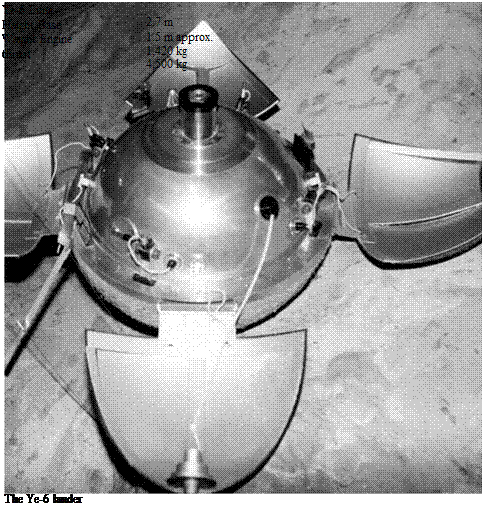YE-6 LUNAR LANDER
The lunar lander was called the Ye-6. In the event, there were two variants: the Ye-6, used up to the end of 1965; and the Ye-6M, used in 1966. The Ye-6 series had two modules. The main and largest part, the instrument compartment, was cylindershaped, carried a combined manoeuvring engine and retrorocket, orientation devices, transmitters and fuel. The lander, attached in a sphere on the top, was quite small, only 100 kg. It was ball-shaped and once it settled on the moon’s surface, a camera would peep up to take pictures. It followed very closely the popular image of what an alien probe landing on Earth would look like.
The main spacecraft was designed to carry the probe out to the moon and land it intact on the surface. The engine, built by Alexei Isayev’s OKB-2, would be fired twice: first, for a mid-course correction, with a maximum thrust of 130 m/sec; and, second, to brake the final stage of the descent. The engine was called the KTDU-5, an abbreviation from Korrektiruiushaya Tormoznaya Dvigatelnaya Ustanovka, or course correction and braking engine) and it ran off amine as fuel and nitric acid as oxidizer. The next most important element was the I-100 control system, built by Nikolai Pilyugin’s Scientific Research Institute NII-885. This had to orientate the spacecraft properly for the mid-course correction and the landing. The mid-course correction was intended to provide an accuracy of 150 km in the landing site. The main module relied on batteries rather than solar power.
The final approach to landing would be the most difficult phase. The rocket on the 1,500 kg vehicle had to fire at the correct angle about 46 sec before the predicted landing. It must brake the speed of the spacecraft from 2,630 m/sec 75 km above the moon to close to 0 during this period. Too early and it would run out of fuel before reaching the surface, pick up speed again and crash to pieces. Too late and it would impact too fast. The main engine was designed to cut out at a height of 250 m. At this stage, four thrusters were expected to slow the spacecraft down to 4 m above the
 |
surface. A boom on the spacecraft would then detect the surface. As it did so, gas jets would fill two airbags and the lander would be ejected free to land safely. Four minutes after landing, a timer would deflate the bags and the lander would open from its shell.
Landing cabin
![]() with petals with arms
with petals with arms
Weight
Ye-6 instruments
• Ye-6M (Luna 13).
• Camera.
• Radiometer.
• Dynamograph/penetrometer (‘gruntmeter’).
• Thermometer.
• Cosmic ray detector.
The lander was egg-shaped, pressurized, metallic-looking and made of aluminium. Inside were a thermal regulation system, chemical batteries designed to last four days, transmitters and scientific equipment. Once stable on the surface, four protective petals would open on the top to release the four 75 cm transmitting aerials. The most important element was of course the camera. Although often described as a television camera, it was more accurately called a pinpoint photometer and took the form of a cylinder with a space for the scanning mirror to look out the side. These are optical mechanical cameras and do not use film in the normal sense, instead scanning for light levels, returning the different levels by signal to Earth in a video, analogue or digital manner. The system was designed by I. A. Rosselevich, built by Leningrad’s Scientific Research Institute NII-380 and was based on systems originally used on high-altitude rockets. The camera was small, only 3.6 kg in weight and used a system of mirrors to scan the lunar surface vertically and horizontally over the period of an hour working on only 15 watts of electricity. The lander would transmit for a total of five hours over the succeeding four days, either on pre-programmed command or on radioed instructions from the ground.
A safe landing required as vertical a descent as possible. From the photography point of view, the Russians wanted to land a spacecraft during local early dawn. The lunar shadows would therefore be as long as possible, providing maximum contrast and enabling scale to be calculated. Once again, Keldysh’s Mathematics Institute calculated the trajectories. Earth-moon mechanics and lighting conditions were such that a direct early dawn descent could come down in only one part of the moon, the Ocean of Storms. This is the largest sea on the moon, covering much of its western hemisphere.
The Americans built a comparable spacecraft, Ranger. Here, the Americans intended to achieve the double objective of photographing the lunar surface and achieve a soft-landing. On Ranger, the main spacecraft was a hexagonal frame which contained the equipment, engine and cameras. As Ranger came down toward the
lunar surface, photographs would be taken until the moment of impact. Ranger’s soft – landing capsule would use a different landing technique: 8 sec before impact and at an altitude of 21.4 km, the landing capsule, with a retrorocket, would separate from the crashing mother craft. The powerful solid rocket motor would cut its speed. The cabin would separate, impact at a speed of not more than 200 km/hr and then bounce onto the lunar surface. Ranger’s landing capsule was about half the size and weight of the Ye-6. It was made out of balsa wood and the instruments would be protected by oil. There was a transmitter and only one instrument: a seismometer (no camera).










